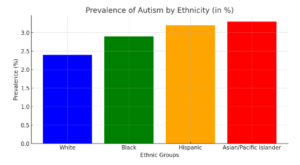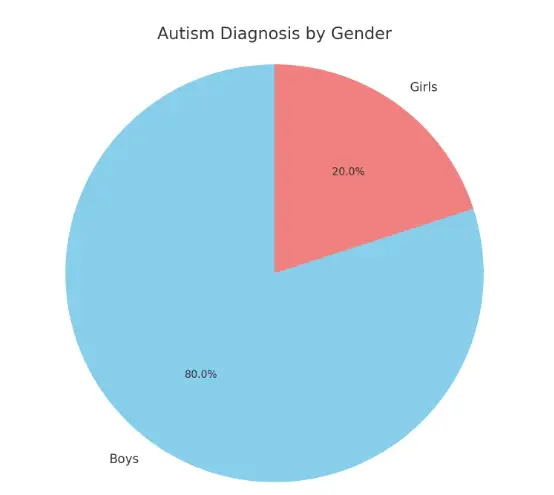Autism: Understanding, Supporting, and Empowering Children with ASD
Table of Contents
Autism Spectrum Disorder (ASD) is a complex developmental condition that influences how children perceive the world and interact with others. In recent years, awareness of this condition has grown, yet many parents, educators, and caregivers are still seeking effective ways to support affected children. This article will explore the causes, signs, and most effective support strategies for children with ASD, helping to foster a better understanding and empower them to thrive in everyday life.
Here are the latest statistics on children with autism:
| Statistic | Data |
| Prevalence in the U.S. | 1 in 36 children |
| Boys diagnosed with autism | 4 in 100 |
| Girls diagnosed with autism | 1 in 100 |
| Average age of diagnosis | 5 years |
| Diagnosis by age 2 (possible) | Yes, but average is age 5 |
| Prevalence by ethnicity | |
| White children | 2.4% |
| Black children | 2.9% |
| Hispanic children | 3.2% |
| Asian/Pacific Islander | 3.3% |
Two key trends:
- Prevalence rising: Autism rates have increased from 1 in 44 in previous years to 1 in 36, likely due to improved awareness and diagnostic practices.
- Gender disparity: Boys are nearly four times more likely to be diagnosed than girls.
Now, I’ll create two visual representations of this data: a bar chart for prevalence by ethnicity and a pie chart for the gender difference. Let me do that.


Here are two graphs based on the latest autism statistics:
- Prevalence of Autism by Ethnicity: This bar chart shows that autism prevalence is highest among Asian/Pacific Islander children (3.3%) and lowest among white children (2.4%).
- Autism Diagnosis by Gender: The pie chart illustrates the significant gender disparity in autism diagnoses, with boys (80%) being diagnosed much more frequently than girls (20%).
What is Autism Spectrum Disorder?
ASD is a developmental condition that impacts communication, behavior, and social relationships in children. It is referred to as a “spectrum” because symptoms and severity can vary widely among individuals. Some children may require minimal assistance, while others may need more comprehensive support. The condition typically presents in early childhood, often before the age of three, and persists throughout life. Although no known cure exists, early intervention can help children develop key skills, manage symptoms, and enhance their quality of life.
Causes of ASD in Children
The exact causes of this condition are not yet fully understood, but research indicates a combination of genetic and environmental factors that contribute to its development.
Genetic Factors
Numerous studies suggest that ASD can run in families, indicating a strong genetic link. Certain gene mutations have been associated with an increased risk of developing the condition. These mutations may occur spontaneously or be inherited from parents. Children born to older parents or those with a family history of developmental disorders may also be at a higher risk.
Environmental Factors
While genetics play a significant role, environmental influences during pregnancy or early childhood may also heighten the risk. Prenatal exposure to certain chemicals or medications, maternal infections, or complications during birth have been linked to the likelihood of developing ASD. However, no single environmental factor has been identified as a direct cause.
The Gene-Environment Interaction
This developmental disorder likely arises from a combination of genetic predisposition and environmental triggers. A child may have a genetic susceptibility, but environmental factors can determine whether the condition manifests and how severe it becomes.

Recognizing the Signs of ASD in Children
The impact of this condition can vary significantly among children, but there are common signs to look for, particularly in two major areas: social communication challenges and repetitive behaviors.
Social Communication Challenges
- Delayed Speech Development: Many children show delays in language development, often speaking later than their peers or struggling with functional language use.
- Difficulty with Non-Verbal Communication: Some children may struggle with eye contact, facial expressions, or understanding body language, often avoiding eye contact or failing to use gestures to communicate.
- Challenges in Social Interaction: Children on the spectrum often find it hard to form and maintain relationships. They might seem uninterested in playing with peers or have difficulty interpreting social cues.
- Lack of Joint Attention: This involves sharing focus with others on an object or event, often lacking in affected children. They might not point at objects to share interest or follow others’ gaze naturally.
Repetitive Behaviors and Restricted Interests
- Repetitive Movements: Hand-flapping, rocking, or spinning are common behaviors. While comforting for the child, they can become disruptive in some settings.
- Rigid Routines: Many children prefer structured routines and may become distressed if those routines are disrupted. For example, they might insist on eating the same food daily or following the same route to school.
- Specialized Interests: It is common for children to develop intense interests in specific topics, objects, or activities—whether it’s trains, dinosaurs, or something more unique.
- Sensory Sensitivities: Many have heightened sensitivities to sounds, lights, textures, or smells, while others may seek intense sensory experiences.
How ASD is Diagnosed in Children
Diagnosing this condition involves a comprehensive process typically conducted by a team of specialists. Early diagnosis is crucial as it enables children to receive the necessary support to develop essential life skills.
Developmental Screening
Pediatricians often conduct developmental screenings during well-child visits to check for delays in communication and behavior. If concerns are raised, a more in-depth evaluation is typically recommended.
Comprehensive Diagnostic Evaluation
This assessment usually involves multiple specialists, including developmental pediatricians, child psychologists, and speech-language pathologists. It includes direct observation of the child, parent interviews, and standardized tests to assess cognitive abilities, social skills, and language development.
Genetic Testing
In some cases, doctors may recommend genetic testing to identify conditions linked to ASD, such as Fragile X syndrome. While this does not diagnose the disorder directly, it can provide insight into underlying genetic factors.
Effective Support Strategies for Children with ASD
Supporting a child with this developmental condition involves personalized approaches tailored to their unique needs. Strategies often focus on improving communication, reducing repetitive behaviors, and developing social skills.
Behavioral Therapies
- Applied Behavior Analysis (ABA): ABA is widely used to teach new skills, reinforce positive behaviors, and reduce challenging ones through structured interventions.
- Early Start Denver Model (ESDM): This early intervention program emphasizes play-based activities that promote language and social skills for toddlers.
- Pivotal Response Treatment (PRT): PRT focuses on enhancing key areas of a child’s development, such as motivation and self-initiative in communication, building foundational skills for social interaction.
Speech and Occupational Therapy
Speech therapy aids many children in enhancing communication abilities, working on articulation and learning to use gestures. Occupational therapy helps with everyday skills such as dressing, eating, and managing sensory sensitivities.
Educational Interventions
Children often require tailored educational plans to meet their learning needs. In the U.S., Individualized Education Programs (IEPs) ensure that they receive specialized instruction, accommodations, and goals to help them succeed in school.
Medications
While no medication treats the condition itself, some can help manage symptoms such as anxiety, depression, or hyperactivity. These medications are typically part of a broader treatment plan and should be monitored closely by healthcare providers.

How Parents and Caregivers Can Support Children with ASD
Parents and caregivers play a vital role in the development of children with this condition. Creating a structured, supportive environment is key to helping them thrive.
- Establish Consistent Routines: Predictable daily schedules help children feel more secure. Any changes in routine should be communicated in advance to reduce anxiety.
- Use Clear Communication: Simple, direct language combined with visual aids can help children understand instructions and expectations.
- Encourage Social Interaction: Gradually introducing social situations in comfortable settings can provide opportunities for practice. Structured activities, like board games or one-on-one playdates, are ideal.
- Reinforce Positive Behaviors: Positive reinforcement, such as verbal praise or small rewards, encourages desirable behaviors like following instructions or using appropriate language.
The Role of Society in Supporting Children with ASD
Beyond individual efforts, society as a whole must create a more inclusive and supportive environment. This involves raising awareness, advocating for the rights of individuals with ASD, and providing access to necessary services.
Public Awareness and Acceptance
While awareness has increased, ongoing efforts are needed to ensure society fully accepts and supports individuals. Community programs, media representation, and public events can help promote understanding and inclusivity.
Advocacy and Legal Protections
In the U.S., children with this condition are protected by laws such as the Americans with Disabilities Act (ADA) and the Individuals with Disabilities Education Act (IDEA). These laws ensure access to appropriate education, healthcare, and support services. Advocacy is still necessary to uphold these rights.
Conclusion
This developmental condition is lifelong, but with the right support, children can lead fulfilling and meaningful lives. Parents, caregivers, educators, and society must collaborate to provide the tools and environments necessary for success. By fostering understanding, providing early intervention, and advocating for inclusivity, we can empower these children to reach their full potential.
References:
- Autism Society of America
- Centers for Disease Control and Prevention (CDC) – Autism Spectrum Disorder
- World Health Organization – Autism Spectrum Disorders
- Diagnostic and Statistical Manual of Mental Disorders (DSM-5)







